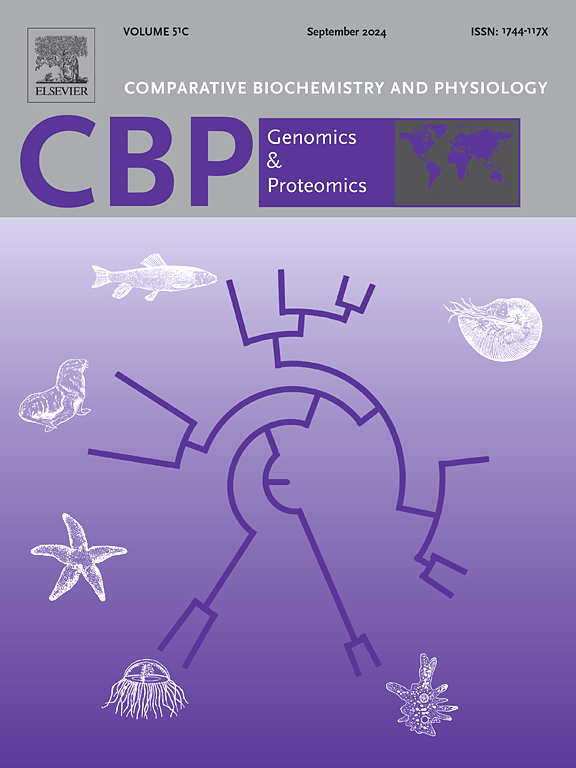The effects of sulfate on the physiology, biochemistry, and intestinal transcriptome of Scylla paramamosain under low-salinity conditions
IF 2.2
2区 生物学
Q4 BIOCHEMISTRY & MOLECULAR BIOLOGY
Comparative Biochemistry and Physiology D-Genomics & Proteomics
Pub Date : 2025-03-30
DOI:10.1016/j.cbd.2025.101502
引用次数: 0
Abstract
Sulfate, a key component of seawater and sulfate-saline-alkali soil, critically impacts aquatic species' physiology. The aim of this experiment was to investigate the effects of sulfate concentration on the growth, survival, microstructure of gills and hepatopancreas, as well as the intestinal immune response and molecular mechanisms of Scylla paramamosain. The experimental groups were categorized as S1 (0 g/L sulfate, sulfate-free), S2 (1 g/L sulfate, optimal concentration), and S3 (2 g/L sulfate, high sulfate concentration). The results showed that with the increase of sulfate concentration in the experimental water, Survival and weight growth rates initially increased but declined at higher sulfate concentrations (P < 0.05), while molting rates progressively decreased. The intestinal ACP and AKP levels in S2 were significantly higher than those in S1 and S3 (P < 0.05). AST and ALT in the S2 group showed no significant difference from those in the S3 group (P > 0.05) but were significantly lower than those in the S1 group (P < 0.05). Sulfotransferases in the S2 group were significantly lower than those in the S1 and S3 groups (P < 0.05). Short-term (72 h) microscopic observations of the gills and hepatopancreas revealed that the gills in both the S1 and S3 groups exhibited thickening of the gill filaments and rupture of the cuticle layer, while the hepatopancreatic tissue in the S3 group also showed enlargement of intercellular spaces, fracture of the basement membrane, and blurred boundaries. Transcriptome sequencing of the S. paramamosain intestine revealed significant upregulation of sulfotransferases in both S1 and S3 groups. GO annotation of DEGs indicated similar responses of S. paramamosain to sulfate-free and high-sulfate environments, maintaining physiological stability by activating protein processing pathways, enhancing blood-lymph coagulation, and regulating redox balance. KEGG analysis revealed that sulfate-free environments predominantly enriched lipid metabolism and secondary metabolism pathways. While those enriched in high-sulfate environments were mainly related to amino acid metabolism and secondary metabolism. The results indicate that both sulfate-free and high-sulfate concentrations affect the growth, survival, and molting rates of S. paramamosain, as well as inducing immune responses in the intestine. In the short term, they can cause structural changes in the gills and hepatopancreas. The intestinal transcriptome expression shows a similar response pattern, but the metabolic pathways differ. This study provides theoretical support and technical guidance for the cultivation of S. paramamosain under low-salinity conditions with sulfate-type saline-alkali water.

硫酸盐对低盐度条件下Scylla paramamosain生理生化和肠道转录组的影响
硫酸盐是海水和硫酸盐盐碱土的关键成分,对水生物种的生理有重要影响。本试验旨在研究硫酸盐浓度对Scylla paramamosain生长、存活、鳃和肝胰腺微观结构以及肠道免疫反应和分子机制的影响。实验组分为S1组(0 g/L硫酸盐,无硫酸盐)、S2组(1 g/L硫酸盐,最佳浓度)和S3组(2 g/L硫酸盐,高硫酸盐浓度)。结果表明,随着试验水体中硫酸盐浓度的增加,成活率和体重生长率先升高后降低(P <;0.05),换羽率逐渐降低。S2期肠道ACP和AKP水平显著高于S1和S3期(P <;0.05)。S2组AST、ALT与S3组比较差异无统计学意义(P >;0.05),但显著低于S1组(P <;0.05)。S2组的硫转移酶显著低于S1和S3组(P <;0.05)。短期(72 h)镜下观察鱼鳃和肝胰脏,S1组和S3组鱼鳃均表现为鳃丝增厚、表皮层破裂,而S3组肝胰脏组织也表现为细胞间隙增大、基膜断裂、边界模糊。对S. paramamosain肠道的转录组测序显示,S1组和S3组的硫转移酶均显著上调。DEGs的GO注释表明S. paramamosain对无硫酸盐和高硫酸盐环境的反应类似,通过激活蛋白质加工途径、增强血淋巴凝固和调节氧化还原平衡来维持生理稳定。KEGG分析显示,无硫酸盐环境主要富集脂质代谢和次级代谢途径。而在高硫酸盐环境中富集的主要与氨基酸代谢和次生代谢有关。结果表明,无硫酸盐浓度和高硫酸盐浓度均影响S. paramamosain的生长、存活和脱毛率,并诱导肠道免疫反应。在短期内,它们会引起鱼鳃和肝胰腺的结构变化。肠道转录组表达表现出类似的响应模式,但代谢途径不同。本研究为硫酸盐型盐碱水低盐度条件下的S. paramamosain栽培提供了理论支持和技术指导。
本文章由计算机程序翻译,如有差异,请以英文原文为准。
求助全文
约1分钟内获得全文
求助全文
来源期刊
CiteScore
5.10
自引率
3.30%
发文量
69
审稿时长
33 days
期刊介绍:
Comparative Biochemistry & Physiology (CBP) publishes papers in comparative, environmental and evolutionary physiology.
Part D: Genomics and Proteomics (CBPD), focuses on “omics” approaches to physiology, including comparative and functional genomics, metagenomics, transcriptomics, proteomics, metabolomics, and lipidomics. Most studies employ “omics” and/or system biology to test specific hypotheses about molecular and biochemical mechanisms underlying physiological responses to the environment. We encourage papers that address fundamental questions in comparative physiology and biochemistry rather than studies with a focus that is purely technical, methodological or descriptive in nature.

 求助内容:
求助内容: 应助结果提醒方式:
应助结果提醒方式:


